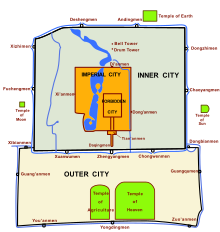This article has multiple issues. Please help improve it or discuss these issues on the talk page. (Learn how and when to remove these messages)
|

The Beijing city fortifications were a series of walls with towers and gates constructed in the city of Beijing, China in the early 1400s until they were partially demolished in 1965 for the construction of the 2nd Ring Road and Line 2 of the Beijing Subway. The original walls were preserved in the southeastern part of the city, just south of the Beijing railway station. The entire perimeter of the Inner and Outer city walls stretched for approximately 60 kilometres (37 mi).
Beijing was the capital of China for the majority of the Yuan, Ming, and Qing dynasties, as well as a secondary capital of the Liao and Jin dynasties. As such, the city required an extensive fortification system around the Forbidden City, the Imperial City, the Inner city, and the Outer city. Fortifications included gate towers, gates, archways, watchtowers, barbicans, barbican towers, barbican gates, barbican archways, sluice gates, sluice gate towers, enemy sighting towers, corner guard towers, and a moat system. It had the most extensive defense system in Imperial China.
After the collapse of the Qing dynasty in 1911, Beijing's fortifications were gradually dismantled. The Forbidden City has remained largely intact, and has become the Palace Museum. Some fortifications remain intact, including Tiananmen, the gate tower and watchtower at Zhengyangmen, the watchtower at Deshengmen, the southeastern corner guard tower, and a section of the Inner city wall near Chongwenmen. The latter two components now form the Ming City Wall Relics Park. None of the Outer city remains intact. Yongdingmen was completely reconstructed in 2004.